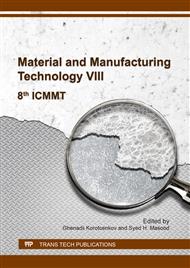[1]
P. Narasimman, M. Pushpavanam, V.M. Periasamy, Wear and scratch resistance characteristics of electrodeposited nickel-nano and micro SiC composites, Wear Vol. 292-293 (2012) 197-206.
DOI: 10.1016/j.wear.2012.05.009
Google Scholar
[2]
A.A. Aal, K.M. Ibrahim, Z.A. Hamid, Enhancement of wear resistance of ductile cast iron by Ni–SiC composite coating, Wear Vol. 260 (2006) 1070-1075.
DOI: 10.1016/j.wear.2005.07.022
Google Scholar
[3]
M. Flouros, Correlations for heat generation and outer ring temperature of high speed and highly loaded ball bearings in an aero-engine, Aerosp Sci Technol Vol. 10 (2006) 611-617.
DOI: 10.1016/j.ast.2006.08.002
Google Scholar
[4]
A. Bächli, M.A. Nicolet, L. Baud, C. Jaussaud, R. Madar, Nickel film on (001) SiC: Thermally induced reactions, Mater Sci Eng B Vol. 56 (1998) 11-23.
DOI: 10.1016/s0921-5107(98)00204-9
Google Scholar
[5]
T. Fujimura, S.I. Tanaka, In-situ high temperature X-ray diffraction study of Ni/SiC interface reactions, J Mate Sci Vol. 34 (1999) 235-239.
Google Scholar
[6]
T.P.D. Rajan, R.M. Pillai, B.C. Pai, Reinforcement coatings and interfaces in aluminium metal matrix composites, J Mate Sci Vol. 33 (1998) 3491-3503.
Google Scholar
[7]
M. Mani, G. Viola, M. Reece, J. Hall, S. Evans, Influence of coated SiC particulates on the mechanical and magnetic behaviour of Fe–Co alloy composites, J Mate Sci Vol. 49 (2014) 2578-2587.
DOI: 10.1007/s10853-013-7954-9
Google Scholar
[8]
B. Kindl, Y.L. Liu, E. Nyberg, N. Hansen, The control of interface and microstructure of SiC/Al composites by sol-gel techniques, Compos Sci Technol Vol. 43 (1992) 85-93.
DOI: 10.1016/0266-3538(92)90135-p
Google Scholar
[9]
A. Ureña, Escalera, P. Rodrigo, J.L. Baldonedo, L. Gil, Active coatings for SiC particles to reduce the degradation by liquid aluminium during processing of aluminium matrix composites: study of interfacial reactions, J Microsc Vol. 201 (2001).
DOI: 10.1046/j.1365-2818.2001.00765.x
Google Scholar
[10]
Z. Wu, B. Shen, L. Liu, Effect of α-Al2O3 coatings on the interface of Ni/SiC composites prepared by electrodeposition, Surf Coat Technol Vol. 206 (2012) 3173-3178.
DOI: 10.1016/j.surfcoat.2011.12.016
Google Scholar
[11]
Z. Wu, L. Liu, B. Shen, C. Zhong, W. Hu, Effect of α-Al2O3 coatings on the mechanical properties of Ni/SiC composites prepared by electrodeposition, Mater Sci Eng A Vol. 556 (2012) 767-774.
DOI: 10.1016/j.msea.2012.07.062
Google Scholar
[12]
Z. Wu, L. Liu, B. Shen, Y. Wu, Y. Deng, C. Zhong, W. Hu, Mechanical behavior of α-Al2O3-coated SiC particle reinforced nickel matrix composites, J Alloy Compd Vol. 570 (2013) 81-85.
DOI: 10.1016/j.jallcom.2013.03.125
Google Scholar
[13]
X.H. Chen, C.S. Chen, H.N. Xiao, H.B. Liu, L.P. Zhou, S.L. Li, G. Zhang, Dry friction and wear characteristics of nickel/carbon nanotube electroless composite deposits, Tribol Int Vol. 39 (2006) 22-28.
DOI: 10.1016/j.triboint.2004.11.008
Google Scholar
[14]
Y.N. Gou, W.J. Huang, R.C. Zeng, Y. Zhu, Influence of pH values on electroless Ni-P-SiC plating on AZ91D magnesium alloy, T Nonferr Metal Soc Vol. 20 Supplement 2 (2010) s674-s678.
DOI: 10.1016/s1003-6326(10)60560-2
Google Scholar
[15]
M.F. He, W.B. Hu, C. Zhong, J.F. Weng, B. Shen, Y.T. Wu, Effect of wear conditions on tribological properties of electrolessly-deposited Ni-P-Gr-SiC hybrid composite coating, T Nonferr Metal Soc Vol. 22 (2012) 2586-2592.
DOI: 10.1016/s1003-6326(11)61504-5
Google Scholar
[16]
K.H. Hou, M.D. Ger, L.M. Wang, S.T. Ke, The wear behaviour of electro-codeposited Ni–SiC composites, Wear Vol. 253 (2002) 994-1003.
DOI: 10.1016/s0043-1648(02)00222-3
Google Scholar
[17]
M. Perle, C. Bareiss, S.M. Rosiwal, R.F. Singer, Generation and oxidation of wear debris in dry running tests of diamond coated SiC bearings, Diamond Rela Mater Vol. 15 (2006) 749-753.
DOI: 10.1016/j.diamond.2005.10.069
Google Scholar
[18]
I. Garcia, J. Fransaer, J.P. Celis, Electrodeposition and sliding wear resistance of nickel composite coatings containing micron and submicron SiC particles, Surf Coat Technol Vol. 148 (2001) 171-178.
DOI: 10.1016/s0257-8972(01)01336-6
Google Scholar
[19]
K. Kato, Abrasive wear of metals, Tribol Int Vol. 30 (1997) 333-338.
Google Scholar
[20]
J.B. Singh, W. Cai, P. Bellon, Dry sliding of Cu–15 wt%Ni–8 wt%Sn bronze: Wear behaviour and microstructures, Wear Vol. 263 (2007) 830-841.
DOI: 10.1016/j.wear.2007.01.061
Google Scholar
[21]
M. Antonov, I. Hussainova, Cermets surface transformation under erosive and abrasive wear, Tribol Int Vol. 43 (2010) 1566-1575.
DOI: 10.1016/j.triboint.2009.12.005
Google Scholar


